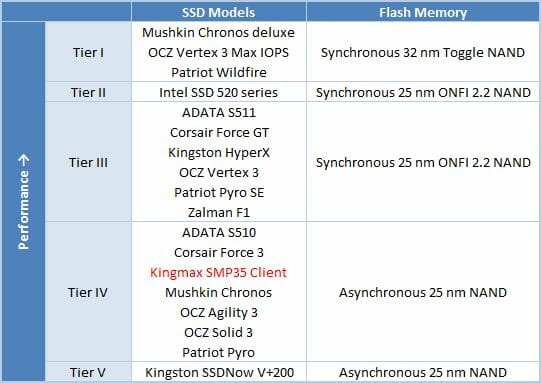Kingmax SMP35 Client 480 GB Solid State Drive Review

It looks like it will be a while before we can wrap up reviews of SSDs based on the second generation SandForce controllers. Today we are going to talk about a product from Kingmax, which intends to win our hearts with a very untraditional combination of features.
Kingmax is known as one of the manufacturers of overclocker-friendly memory modules. The brand gained some recognition by using nanotechnologies for cooling. Instead of conventional heatsinks, Kingmax’s innovative memory modules have their chips coated with some heat-conductive compound which is porous at nano-level and thus facilitates heat dissipation.
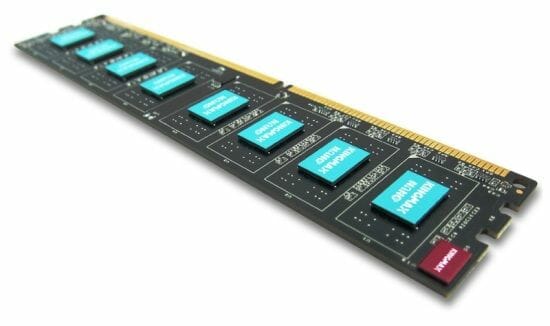
Memory modules for enthusiasts are not the only market Kingmax is active on, though. Like many other firms that had started as memory makers, Kingmax eventually came to produce various small peripherals and NAND flash products such as USB flash drives, memory cards, card-readers, external hard disks, and solid state drives. There’s nothing extraordinary about this product range since many other companies offer the same but Kingmax should be given credit for looking for original solutions not only with their overclocker-friendly memory. Today, we are going to take a look at a Kingmax SSD that combines a high storage capacity with a low price. It is the 480-gigabyte SMP35 Client model with SATA III interface. Its cost per gigabyte of storage is close to the psychological barrier of $1.
We can tell you right away that the SSD is based on a second-generation SandForce controller, which is the only hardware platform available for manufacturers who do not have their own development resources. SandForce offers its partners a ready-made SSD platform consisting of a controller, firmware and reference PCB design. This platform has become widespread under many brands but Kingmax seems to have got some ideas about bringing the price down to a lower level than usual. So, let’s try to find out the secret of the Kingmax SMP35 Client 480GB and see if it can make a worthy competitor to other large-capacity SSDs with SandForce as well as other controllers.
Closer Look at Kingmax SMP35 Client 480GB
Our sample of the Kingmax drive is packed into a cardboard box which is considerably larger than the dimensions of a standard 2.5-inch device. The general advantages of the product, which can be applied to nearly any modern SSD, are listed on the front of the box while the opposite side offers a list of rather meaningless specs like “read speed up to 550 MB/s”.
The large size of the box turned out to be deceptive. We could only find a standard set of accessories inside. Besides the SSD, the box contains a small user manual, an adapter to install the SSD into a 3.5-inch bay, and four mounting screws. Most of the box is occupied by a protective plastic carcass.
We must confess that the manufacturer’s website, like the text on the product box, does not clarify anything about the performance and positioning of the Kingmax SMP35 Client. Besides the fact that the makers of SandForce-based SSDs usually declare maximum possible data-transfer speeds which refer to ideal scenarios with easily compressible data, Kingmax complicates things even more by declaring identical specs for almost all of its SATA 6 Gbit/s SSDs. We can only find out what hardware configuration this SSD has by opening it up.
The SMP35 Client looks like a black anodized aluminum brick with gaudy and carelessly affixed labels. The thickness of the “brick” is 7 millimeters instead of the conventional 9.5 millimeters, which allows installing the slim SMP35 Client into compact notebooks or even ultrabooks.
We don’t find anything surprising inside. The SSD contains a typical PCB with a SF-2281 controller and 16 BGA-packaged NAND flash chips. Like with system memory, Kingmax rebrands the chips, although we know that Kingmax is no flash memory maker. The company is not even a member of the ONFI consortium. So, the memory we see here must have been made by Micron or Intel and is NAND flash with asynchronous interface. Each chip is 256 gigabits in capacity, containing four 64-gigabit 25nm semiconductor dies. Thus, the SF-2281 controller uses 8-way interleave to access all the chips across its eight channels. This is the highest configuration the controller supports.
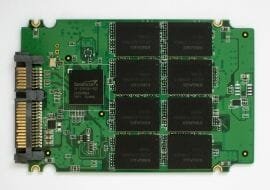
The SMP35 Client 480GB doesn’t seem to implement any special solutions. It’s just a large-capacity SSD with inexpensive and rather slow asynchronous flash memory. However, other SSD makers do not favor such products, suggesting that large capacities must be made out of fast flash memory. We’ll see if the low memory speed can be made up for by the maximum interleave in this Kingmax model.
Like the majority of other SandForce-based SSDs, the Kingmax SMP35 Client reserves 14% of its total capacity for the RAISE technology (Redundant Array of Independent Silicon Elements), so the user-accessible storage amounts to 480 gigabytes (or 447 gibibytes) out of its total 512 gigabytes. Although SandForce has permitted to increase the percentage of user-accessible storage in the recent firmware versions, ADATA is the only manufacturer to use this opportunity so far. Well, RAISE is especially important for inexpensive SSDs because it helps to mask the defects associated with cheap flash memory.
The SMP35 Client has firmware version L0306, Kingmax obviously using some internal nomenclature which differs from SandForce’s. Judging by its release date, this firmware should be free from the old instability issues the SF-2281 controller used to have in Windows.
Winding up the descriptive part of our review, we want to show you the official specs of the SMP35 Client 480GB taken from the Kingmax website. They seem rather unrealistic to us, though:
- Controller: SandForce SF-2281;
- Interface: SATA 6 Gbps;
- Flash-memory: asynchronous 25 nm NAND;
- Size: 480 GB;
- Cache-memory: none;
- Sequential read speed: 550 MB/s;
- Sequential write speed: 520 MB/s;
- Random read speed ( 4 KB blocks): 60000 IOPS;
- Random write speed ( 4 KB blocks): 60000 IOPS.
Like the majority of SSD makers, Kingmax offers a 3-year warranty for its products.
Testbed Configuration
For our today’s SSD test session we put together a system on an Intel H67 based mainboard. This chipset provides support for two SATA 6 Gbit/s ports, which we use to connect the tested SSDs.
We are going to compare Kingmax SMP35 Client 480 GB against a few different SSDs with the similar storage capacity supporting contemporary SATA 6 Gbps interface. They are a SF-2281 based SSD with typical synchronous ONFI memory (OCZ Vertex 3), as well as a pair of SSDs on Everest and Everest 2 chips (OCZ Octane and OCZ Vertex 4).
Overall our testbed was configured as follows:
- Intel Core i5-2400 (Sandy Bridge, 4 cores, 3.1 GHz, EIST and Turbo Boost turned off);
- Foxconn H67S mainboard (BIOS A41F1P03);
- 2 x 2 GB DDR3-1333 SDRAM DIMM 9-9-9-24-1T;
- Crucial m4 256 GB system disk (CT256M4SSD2);
- Tested SSDs:
- Kingmax SMP35 Client 480 GB (KM480GSMP35, firmware version L0306);
- OCZ Octane 512 GB (OCT1-25SAT3-512G, firmware version 1.13);
- OCZ Vertex 3 480 GB (VTX3-25SAT3-480G, firmware version 2.22);
- OCZ Vertex 4 512 GB (VTX4-25SAT3-512G, firmware version 1.4).
- Microsoft Windows 7 SP1 Ultimate x64
- Drivers:
- Intel Chipset Driver 9.3.0.1019;
- Intel Graphics Media Accelerator Driver 15.22.54.2622;
- Intel Rapid Storage Technology 11.1.0.1006.
Performance
Random and Sequential Read/Write
We use CrystalDiskMark 3.0.1 benchmark to test the random- and sequential read and write speed. This benchmark is convenient to work with as it can measure the speed of an SSD with both incompressible random and fully compressible recurring data. This feature is important for testing SSDs based on SF-2281/2282 controller, which tries to compress the data before writing it into memory. So, there are two numbers in the diagrams below that reflect the maximum and minimum SSD speed. The real-life performance of an SSD is going to be in-between those two numbers depending on how effective the controller data compression is.
Note that the performance tests in this section refer to SSDs in their “Fresh Out-of-Box” state (FOB). No degradation could have taken place yet.
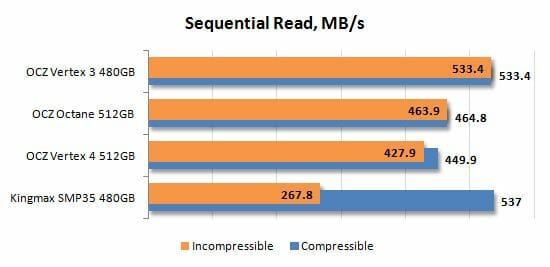
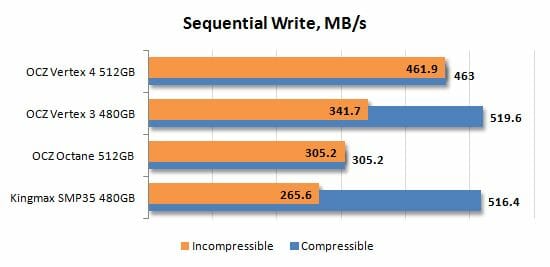
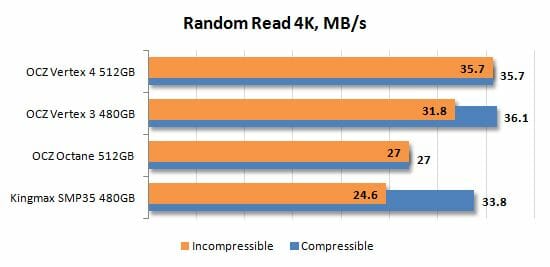
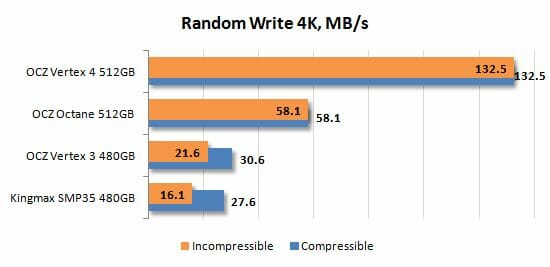
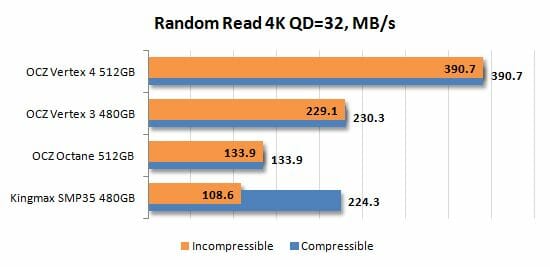
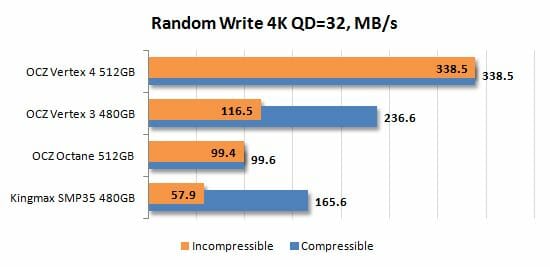
The Kingmax SMP35 Client 480GB can serve as a good illustration of the performance of second-generation SandForce controllers. You can see that its speed depends greatly on whether data are compressible or not.
When processing compressible files, the SSD is fast and competes with the Vertex 3. In other words, the SMP35 Client can match the best SATA III SSDs at sequential operations and when reading with a short request queue. But when it comes to incompressible data, the SandForce magic evaporates, exposing the low bandwidth of the asynchronous flash memory interface and making the SMP35 Client 480GB the worst SSD in this test.
Thus, the Kingmax is going to be always slower than SandForce-based SSDs with synchronous flash, such as the Vertex 3. Its standing relative to other SSDs is going to depend on the particular load. We’ll check the SML35 Client out in real-life applications shortly. Right now let’s run our performance degradation tests.
Degradation and Steady-State Performance
Unfortunately, SSDs are not always as fast as in their “fresh” state. In most cases their performance goes down after some time and in real life we deal with completely different write speeds than what we see on the diagrams in the previous chapter of our review. The reason for this phenomenon is the following: as the SSD runs out of free pages in the flash memory, its controller has to clear memory page blocks before saving data into them, which causes substantial delays. Although, modern SSD controllers can alleviate the performance drop by erasing unused flash memory pages ahead of time, when idle. They use two techniques for that: idle-time garbage collection and TRIM.
Of course, users are more interested in the consistent performance of their SSDs over a long period of time rather than the peak speed they are going to see only during the initial short-term usage period, while the drive is still “fresh”. The SSD makers, however, declare the speed characteristics of “fresh” SSDs for marketing reasons. That’s why we decided to test the performance hit that occurs when a “fresh” SSD becomes a “steady” one.
To get a complete picture of SSD performance degradation we ran special tests based on the SNIA SSSI TWG PTS (Solid State Storage Performance Test Specification) methodology. The main idea of this approach is to measure write speed consecutively in four different cases. First we measure the “fresh” SSD speed. Then we measure the speed after the SSD has been fully filled with data twice. The third test occurs after a 30-minute break during which the controller can partially restore performance by running the idle-time garbage collection. And finally, we measure the speed after issuing a TRIM command.
We ran the tests in synthetic IOMeter 1.1.0 RC1 benchmark, where we measured random write speed when working with 4 KB data blocks aligned to flash memory pages at 32 requests queue depth. The test data were pseudo-random.
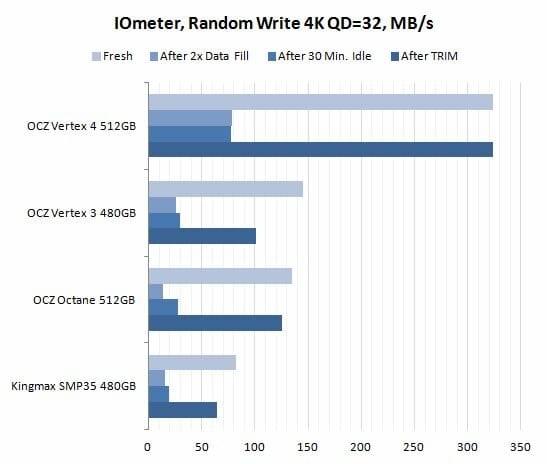
Like every other SSD with a second-generation SandForce controller, the Kingmax SMP35 Client 480GB isn’t good at background garbage collection and can only restore its performance by means of the TRIM command. However, even TRIM can’t bring the SSD back to its original state. The steady-state performance of the SMP35 Client 480GB is somewhat lower than its out-of-box speed. This refers to writing only, though. You can see the performance degradation as measured by CrystalDiskMark 3.0.1 in the following diagrams. The SSD is filled with random data here.
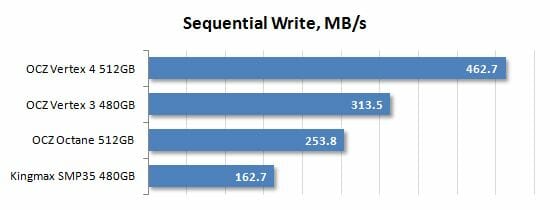
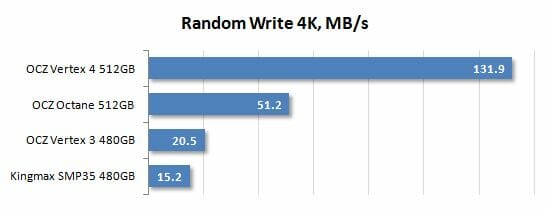
The SMP35 Client 480GB faces as many as three unfavorable factors in this test: writing, incompressible data and not being right out of the box. As a result, this SSD falls far behind each of its opponents. The OCZ Vertex 4, based on the Everest 2 controller which doesn’t compress data, is many times as fast as the Kingmax. On the other hand, we should keep it in mind that write operations are less frequent than read ones in real usage scenarios, so the failure of the Kingmax in this test isn’t a catastrophe.
Futuremark PCMark7
The popular PCMark 7 contains an individual disk subsystem benchmark. It is not a synthetic test, but is based on real-life applications. This benchmark reproduces typical disk usage scenarios and measures how fast they are completed in popular applications. Moreover, the disk access commands are not executed as a steady uninterrupted flow, but in a more realistic manner – with certain pauses caused by the need to process the data. The benchmark generates an overall disk subsystem performance rating as well as speed readings in MB/s in individual usage scenarios. Note that the absolute speed in these scenarios is not too high because of the above mentioned pauses between individual input/output operations. In other words, PCMark 7 shows you the speed of the disk subsystem from the application’s point of view. Numbers like that show us not only the pure performance of an SSD, but mostly how big of a performance gain a certain SSD can guarantee in real life.
We ran PCMark 7 on “steady” SSDs, which is what they are going to be in actual computer systems most of the time. Their performance in this case is affected not only by their controller or flash memory speed but also by the efficiency of their internal algorithms that fight performance degradation.
The PCMark 7 score is a good guide for people who don’t want to delve into technicalities but need a simple illustration of relative performance of SSDs in typical desktop applications. As we can see, the Kingmax SMP35 Client 480GB isn’t so bad here. Yes, it is slower than the more expensive Vertex 3 and 4, but faster than the OCZ Octane. Thanks to its attractive price/performance ratio, Kingmax’s solution to use asynchronous flash in a large-capacity SSD looks viable.
Now let’s check out the individual tests to get a more detailed picture of what our SSDs are capable of under various types of operational load:
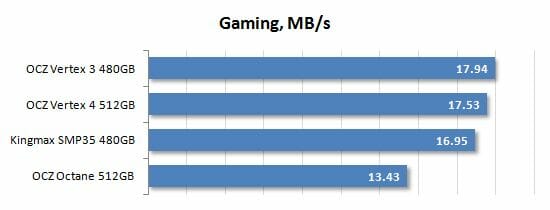
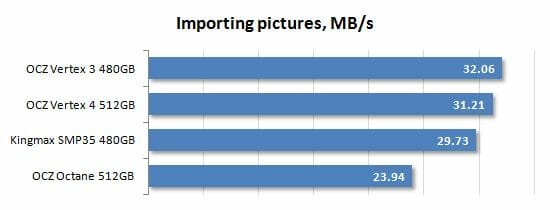
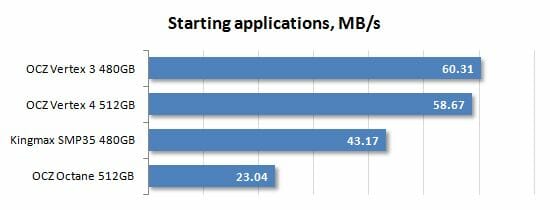
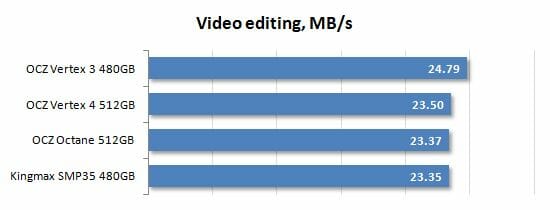
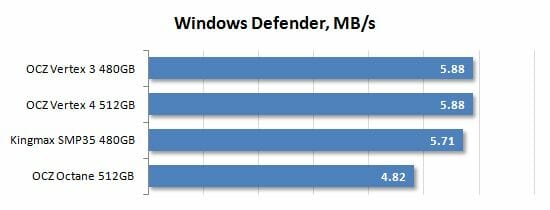
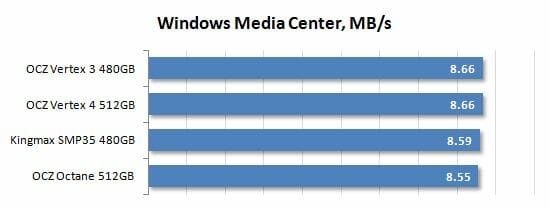
Whatever the load type, the Kingmax SMP35 Client 480GB remains in the same position between OCZ’s Vertex and Octane series and delivers average performance in typical scenarios. It won’t be breaking any records, yet will be suitable enough for today’s top-end computers.
Intel NAS Performance Toolkit
Intel NASPT is another disk sub-system test that uses real-life usage scenarios. Like PCMark 7, Intel NASPT reproduces predefined disk activity traces and measures how fast they are executed. However, the default traces are designed for network attached storage devices rather than for SSDs. Therefore during our test session we replace them with the specially developed SSD Benchmarking Suite which offers more relevant usage scenarios such as compressing and decompressing files, compiling large projects, copying files and folders, loading 3D game levels, installing software, batch-processing photos, searching a digital library for data, mass-launching applications, and transcoding video.
Like PCMark 7, this benchmark gives us a true-to-life illustration of disk subsystem performance. Here the SSDs are again tested in their “steady” state.
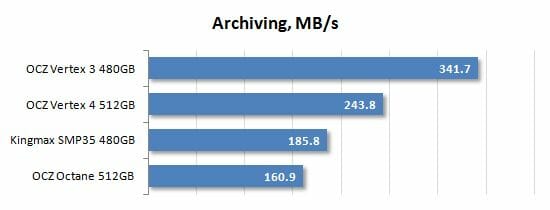
After delivering average performance in Futuremark PCMark 7, the Kingmax SMP35 Client 480GB finds itself in last place according to Intel NASPT, close behind the OCZ Octane. We shouldn’t worry about that until we check out the individual subtests, though. The detailed INASPT results help us see what usage scenarios are the most suitable for our today’s testing participants.
Note that the data-transfer rate is higher than the SATA III interface bandwidth in some subtests. That’s because INASPT is a high-level test that uses standard Windows functions to access the disk subsystem. As a result, the OS caching mechanisms also affect the results.
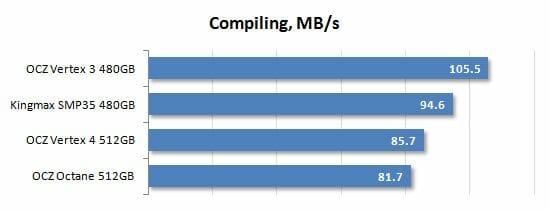
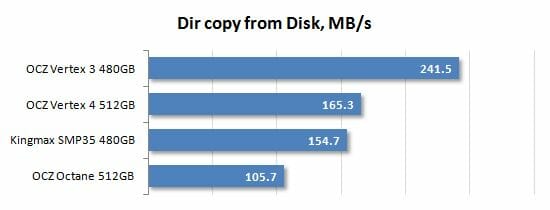
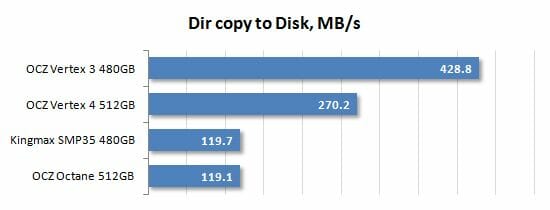
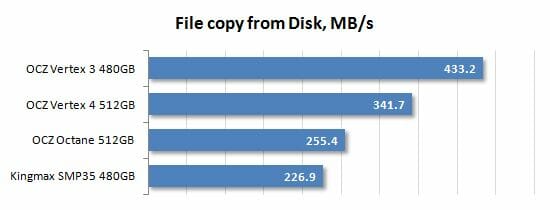
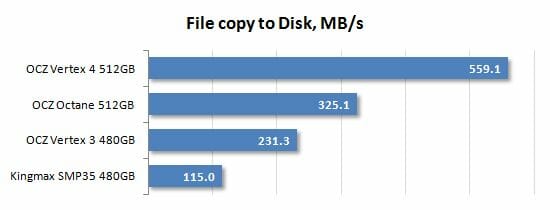
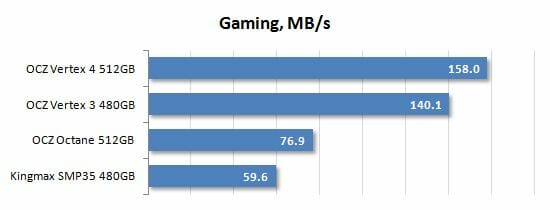
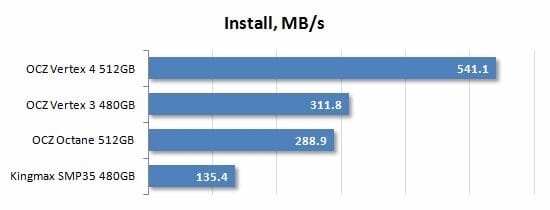
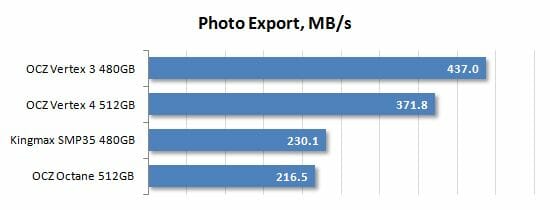
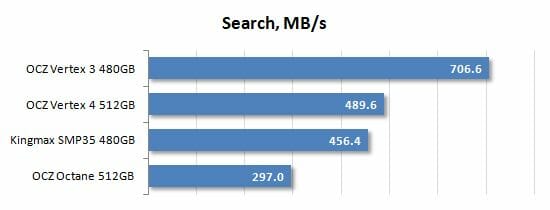
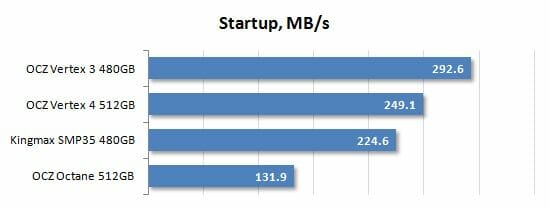
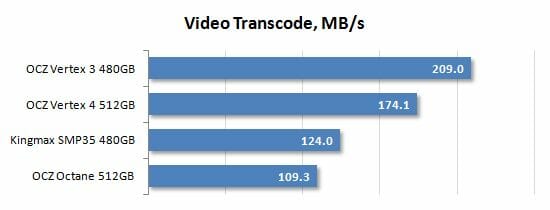
The low overall score of the Kingmax SMP35 Client 480GB in Intel NASPT is due to its low performance in four subtests, three of which are about copying large files to the SSD and the fourth one is a gaming load. On the other hand, there are usage scenarios that highlight the strong points of the Kingmax solution. For example, it outperforms the Vertex 4 in the software compilation subtest.
File Copy Speed
We use AS SSD version 1.6.4237.30508 to benchmark the speed of copying files within a single partition the size of the whole SSD. The SSDs are tested in their steady state.
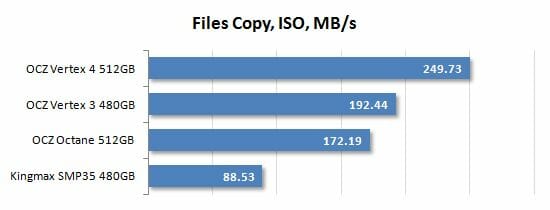
Copying files within the same disk partition requires that the SSD be fast both at reading and writing. And writing is not among the fortes of the SMP35 Client 480GB, especially when it comes to incompressible data. Therefore the SSD from Kingmax is at the bottom of the diagrams here.
Conclusion
The Kingmax SMP35 Client 480GB is based on a second-generation SandForce controller and uses flash memory with asynchronous interface. It’s like a medical diagnosis. Any professional will understand from this description what this SSD is capable of: it’s going to be rather slow but inexpensive.
All this totally applies to Kingmax SMP35 Client 480GB SSD. It doesn’t boast record-breaking speeds, but its key feature is high capacity. There are actually not so many large-capacity SSDs on the market and, compared to them, the Kingmax may become quite attractive. Our tests suggest that it is almost always faster than the same-capacity OCZ Octane and is only inferior to more expensive solutions like OCZ’s Vertex 3 and 4 series. So, if you want a large-capacity SSD as a full replacement for a conventional hard disk, the Kingmax SMP35 Client 480GB should certainly be considered, especially as its SandForce controller can give it a substantial performance boost with compressible data.
Summing up all of our SSD-related tests, we keep on filling in our summary table where all SSDs are distributed over several tiers according to their speed. The tiers differ greatly from each other, but the SSDs inside each tier are almost identical in terms of performance.
